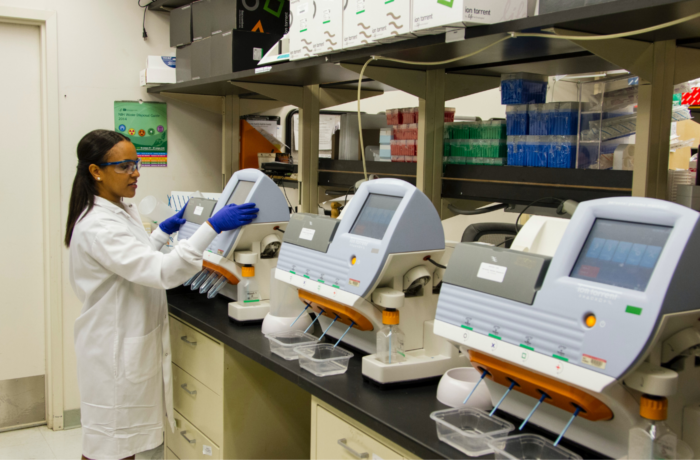You don’t need to be a scientist or an analyst at the World Economic Forum to understand that the way we manufacture products is changing daily, and it’s changing faster than anyone thought possible.
The manufacturing industry has been innovating and evolving constantly over the last 100 years with each industrial revolution catapulting our ability to produce things faster, cheaper and at a higher quality. However, we are now in uncharted territory with innovation happening at varying levels globally at an exponential rate. As a direct effect, we are now seeing the creation of new roles that have never existed before.
Last year the OECD found that “the tasks that AI and robots cannot do are shrinking rapidly.” The report went on to say that 14% of jobs across 32 countries are “highly vulnerable” to automation and close to one in two jobs are likely to be influenced with manufacturing businesses most affected. Companies that embrace this change and drive innovation will continue to not only survive but thrive in what is arguably one of the most competitive free markets that has ever existed.
Understanding this at a manufacturing site level and making plans to ensure there is not a lack of essential talent is crucial for both the site General Manager and for site engineering leads. The bottom line is that by automating or improving the current systems within a production facility, you can increase production, reduce cycle times, improve quality, reduce manufacturing lead times and create a safer workplace while continuing to become more competitive. However the talent to enhance, implement and maintain these systems has never been harder to attract. Consumer demand is driving vast industry expansion across all sectors and with only a limited number of individuals entering the job market with an education and experience in automation, the gap continues to widen. Combined with the fact that most manufacturing facilities are less than ideally located (located in cheaper real estate areas), hiring managers and talent acquisition teams are not only finding a lack of talent but a much more expensive talent market.
After lowering their corporate tax rates in 2003 to 12.5%, Ireland opened its doors to businesses around the world becoming an optimal location for pharmaceutical and biopharmaceutical companies to set up shop. Not only did they suddenly have a greater geographical proximity to mainland Europe than before, but they also had access to international shipping across the Atlantic, taking advantage of the lucrative markets in North America. Five of the worlds eight top selling drugs are now produced in Ireland, making it the world’s largest net exporter of pharmaceuticals globally. With the rise in manufacturing sites and competition, automation specialists took advantage of the talent shortage in Ireland. Simple supply and demand principles created by the economical expansion allowed many professionals to demand and achieve $100+ hour contract rates transforming it into a sellers market.
Looking ahead, companies should be investing in their existing workforce and supporting them in learning new automation skills by actively hiring outside trainers or by allowing managers and experts to have more time off the manufacturing floor to provide essential programmes to their teams. Employers need to recognise that the role of mechanics and engineers are changing with the introduction of new technology and therefore re-skilling should be focused on now before new innovations are implemented, rather than during the installation of a new system.
Engineering teams should be heavy with automation talent and hiring proactively rather than reactively. Building pipelines of inactive/ passive candidates and understanding just how many people have the skill set they need. This way, you know the size and constraints of the talent market in your location or country but also you can be ready to implement a talent sourcing strategy at just a moments notice. That means investing in research and partnering with external talent partners now, who can slowly build that research and those networks on your behalf.
An alternative is that you give in to the contract engineers that have the level of experience you need and pay €100+ hourly rates. You will witness your own budget exhausting €150,000 – €250,000+ (per person) a year on talent and knowledge that you could lose at a moments notice. The knowledge that they gain and grow of your IT systems, PLCs, and equipment goes with them to their next contract with the competition for this talent increasing substantially over the last few years. They too are becoming scarce and well rewarded to stay within existing projects. The prices requested by interim automation talent to change contracts has continued to climb over the last 5 years.
Automation engineers are your front line team to embrace the ever evolving systems at your manufacturing site and they will continue to acquire additional responsibilities as more processes and systems move from personnel to automation. The more of your staff that you can acquire on permanent basis and retain within your existing teams is crucial to the long term strategy for any site, before becoming dependent on contractors and external engineering firms.
What are you seeing in the market? What else have you done to help prevent such shortages in perm talent? (across automation or elsewhere!)
Sources:
Parolin, Z. (2019), “Automation and occupational wage trends”, OECD Social, Employment and Migration Working Papers, No. 228, OECD Publishing, Paris, https://doi.org/10.1787/596b32ce-en.
Nedelkoska, L. and G. Quintini (2018), “Automation, skills use and training”, OECD Social, Employment and Migration Working Papers, No. 202, OECD Publishing, Paris, https://doi.org/10.1787/2e2f4eea-en.








